‘Detox’ is a buzzword for the many diet plans and recipes suggested to cleanse a particular organ or perhaps your entire body. Short for detoxification, detox refers to ridding our body of toxic substances. In truth, the body is already equipped with amazing and effective systems to manage waste and toxin removal. There are some dangerous toxins which require special treatment if you are exposed. However, for the average person, keeping the body detoxified means supporting the systems already active in the body - and practicing healthy low-toxin habits.
So, what are the body’s detoxification systems, and how can yoga for detox support them to function at their best?
The liver and kidneys filter waste products and toxins from the blood so they can be passed out of the body in urine or faeces. Waste from the digestive system is passed out as faeces. The skin excretes some waste products in sweat, and the lungs exhale carbon dioxide and other unwanted gases with every breath.
All these organs benefit from a healthy regular practice of yoga, but there is one more waste removal system that plays a huge role in human health and wellbeing. It’s called the lymphatic system, and it’s especially well supported by yoga.
The Lymphatic System
The lymphatic system is made up of lymph nodes, some lymphoid tissues in other organs, and a one-way network of tiny lymph vessels throughout the entire body. The lymph vessels don’t carry fuel or oxygen to the cells like blood does, nor are they powered by the beating of the heart. Instead, they are a waste collection system powered partly by tiny muscle fibres in the vessel walls.
Here’s how the lymphatic system helps to detoxify the body:
- Absorbing excess fluids from the space between cells. If this function becomes ineffective, fluids accumulate to form swelling.
- Collecting waste products produced by cells inside our bodies. If left to accumulate in the tissues, these wastes would result in disease or disorders.
- Delivering bacteria and cancer cells to the lymph nodes and lymphoid tissues, where the immune system can detect and attack them.
- Absorbing some of the unwanted fats in our diet from the intestines.
How yoga supports the lymphatic system
There are five known pathways by which yoga assists the lymphatic system to detox the body.
- Inversions reverse the effect of gravity, helping lymph fluid to drain from the legs.
- Twists (as well as forward, backward, and side bends) stimulate the flow of lymph through the core of your body.
- Breathing acts as a lymphatic pump. Breathing exercises and Pranayama help the flow of lymph through the deep vessels of the chest.
- Contracting and releasing large muscles helps to move lymph fluid along the lymph vessels towards the lymph nodes and elimination.
Hatha Yoga is particularly useful for supporting the lymphatic system. The steady holds and alternating relaxed postures of Hatha Yoga minimize the production of lactic acid. Lactic acid is a common waste product in other forms of exercise, and as a waste product it must be removed by the lymphatic system. Hatha Yoga allows the lymphatic system to benefit from movement and muscle contractions without being challenged with removing the resulting lactic acid waste.
Yoga for Detox
Breathing exercises for detox
The lungs are vulnerable to inhaling bacteria, viruses and other toxins with every breath we take. To protect our health, we have a complex web of lymph vessels within our lungs delivering unwanted material to lymph nodes for management. Breathing exercises have varying effects including increased lung expansion, improved emptying of the lungs and increased movement of the lungs and surrounding tissues. All of these things contribute to increasing the movement of lymph and therefore the removal of toxins.
Kapalbhati
Also known as Shining Skull Breath, Kapalbhati is an excellent breathing exercise traditionally classified as a cleansing exercise. It works the lungs and muscles by pumping air out during forceful exhalations. To boost your immune system and detoxify your body, practice the following steps to perform Kapalbhati (Choose a more calming breathing exercise if you suffer from hypertension, anxiety, or panic attacks):
- Find a comfortable upright sitting position, with your spine long and tall.
- Take an abdominal breath in to prepare for pumping.
- Contract your abdominal muscles to forcefully exhale from the nose.
- Relax your abdominal muscles naturally, for inhalation.
- Avoid inhale actively - instead release your abdomen and allow the air to be sucked in passively.
- Try practicing 30 pumps in a set, then relax before repeating to a total of three sets.
- In between sets, take a deep breath, and release, then a gentle abdominal breath and retain the breath. Increase the holding time from set to set. So first 20 seconds, then 30 seconds, and after the last set 40 seconds (adapt to suit your experience and capacity).
Sun Salutations for detox
As Sun Salutations (Surya Namaskar) flow through a variety of poses, they activate many different muscles. The variety of muscle contractions and changes in position and pressure in the body benefits lymph flow.
There are many versions of Sun Salutations. You can learn more about them and choose a version to practice in our guide to Surya Namaskar.
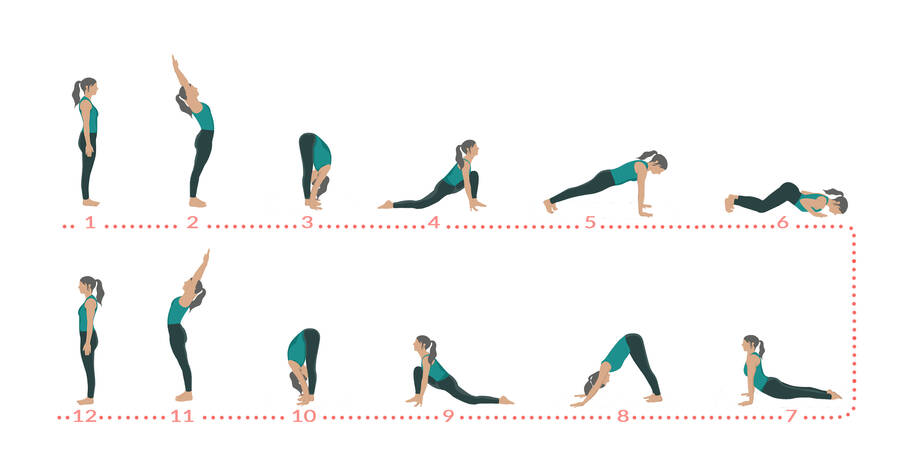
Classical Surya Namaskara - Hatha Yoga
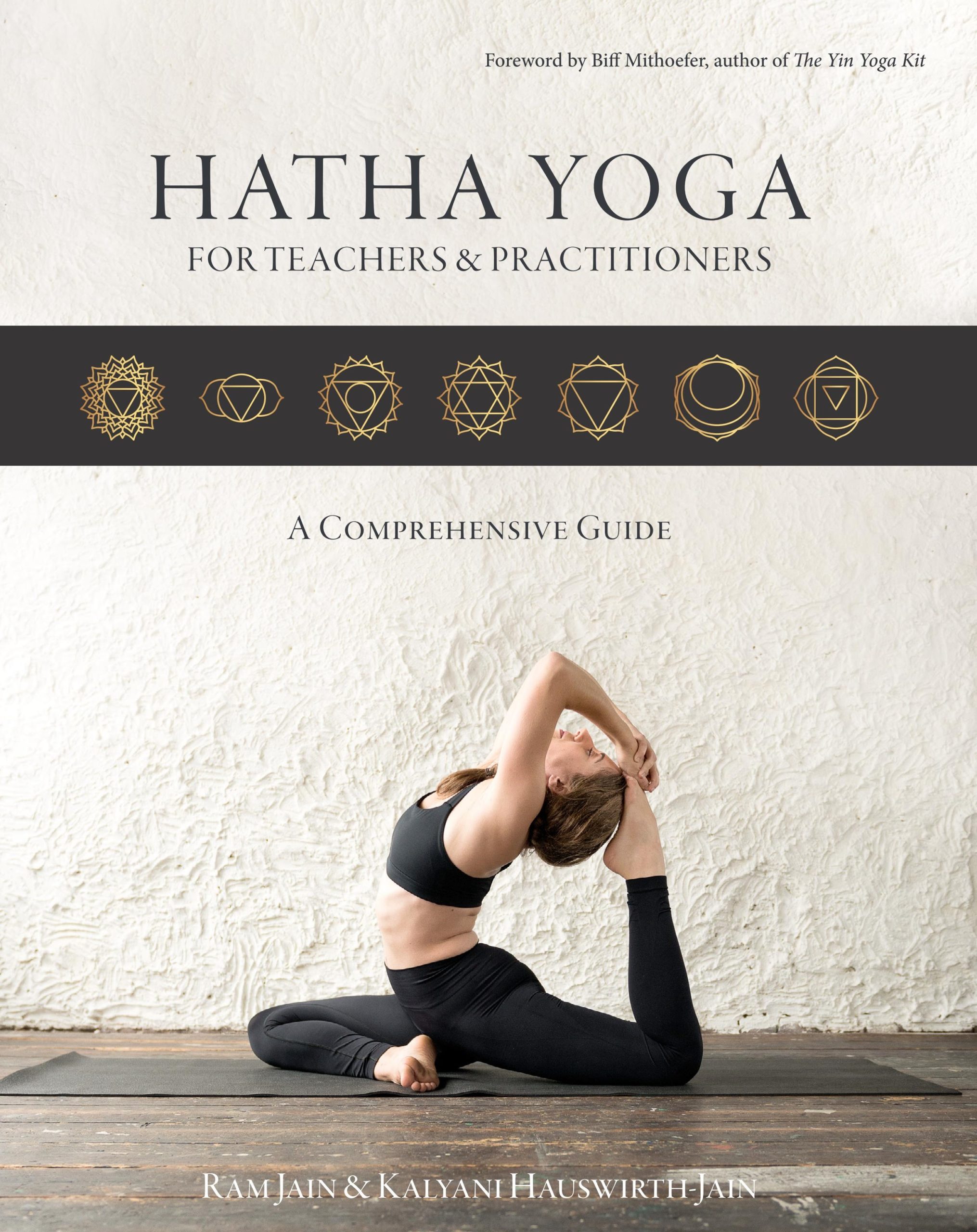
Get a free copy of our Amazon bestselling book directly into your inbox!
Learn how to practice, modify and sequence 250+ yoga postures according to ancient Hatha Yoga principles.
Dynamic yoga poses for detox
Some yoga asana are well suited to a rhythmic or repeated flow of movement. This can be excellent for encouraging lymph flow.
Dynamic half bridge (pelvic raises)
Practicing dynamic Half Bridge Pose:
- Lie on your back, bend your knees, and bring your feet close to your hips. Keep your feet hip-width apart and heels on the floor.
- Place your hands by your sides, palms facing downward.
- Breathe in, push your hands into the floor, and slowly lift your hips up to the ceiling. Allow your individual mobility to govern the height of your lift.
- Reach with your hands toward your ankles and bring your chest toward your chin.
- Breath out as you roll the spine back down to the floor vertebra by vertebra.
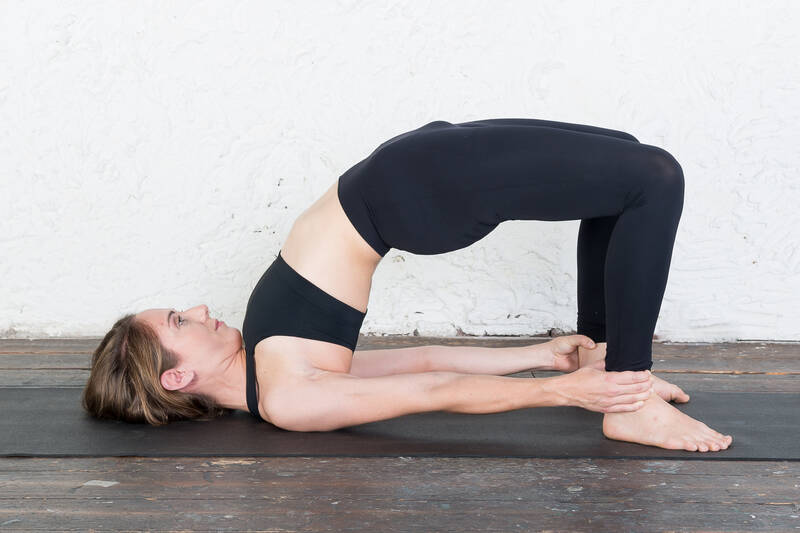
Half Bridge Pose (Ardha Setu Bandhasana)
Cat Pose - Marjaryasana I & II

Cat Pose (Marjaryasana) I
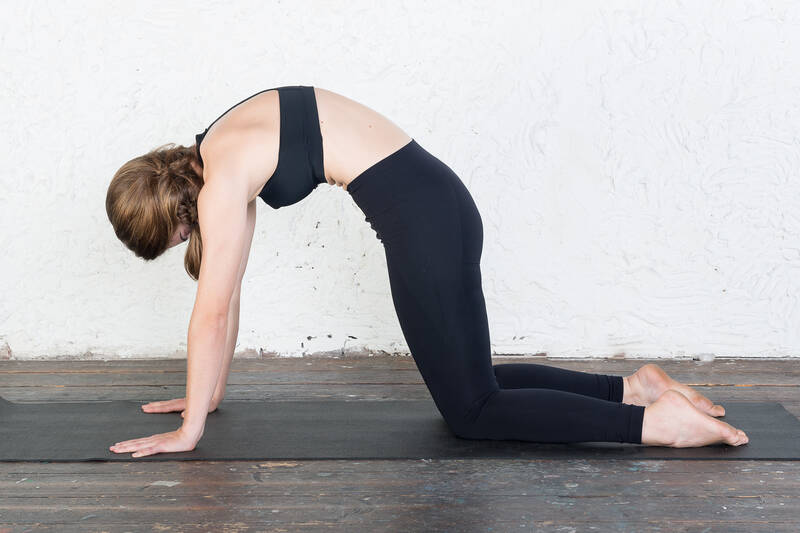
Cat Pose (Marjaryasana) II
Practicing dynamic Cat Pose I & II
- Begin on all fours, with knees under hips and your wrists under shoulders.
- As you inhale, arch your back, open the chest, push your belly button toward the floor, and look up/forward (Marjaryasana I).
- As you exhale, push your hands and knees into the floor and round your back as much as possible,
- bringing your chin to your chest and the middle back toward the ceiling (Marjaryasana II).
Yoga inversions for detox
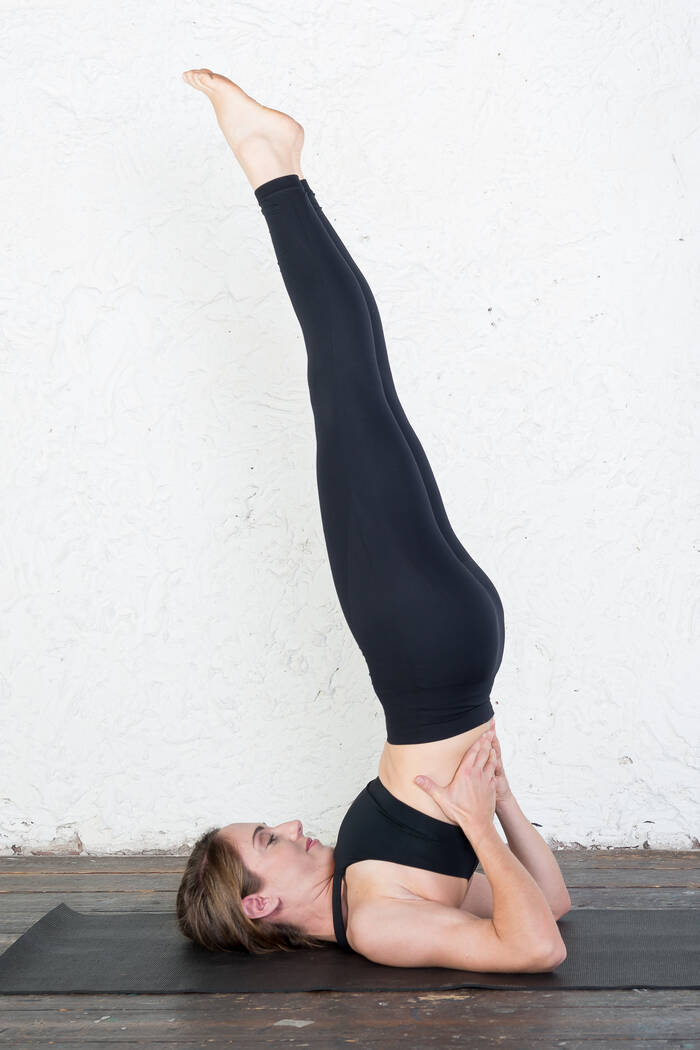
Shoulderstand (Sarvangasana)
Any inversion can be considered useful for reversing the force of gravity on the inverted part of the body. This assists lymph drainage from areas where the lymph flow normally has to work against gravity.
Easy Shoulderstand (Sarvangasana) (instructions in linked guide) is particularly recommended. The pose can be modified with padding under the shoulders to reduce pressure on the neck. Bending the knees and placing the feet against a wall can also help with holding the pose in a restful way. Even when supported, beginners should hold the pose for only thirty seconds to a minute.
Yoga asana for detox
Many yoga asana benefit the organs and systems of detoxification, particularly the lymphatic system. For the greatest lymphatic benefit, poses for detox should be practiced using the Hatha Yoga principle of relaxing in a resting pose between more active poses. This reduces the creation of lactic acid. Here are some examples of poses that are particularly useful in supporting detox via the lymphatic system.
Gate Pose - Parighasana
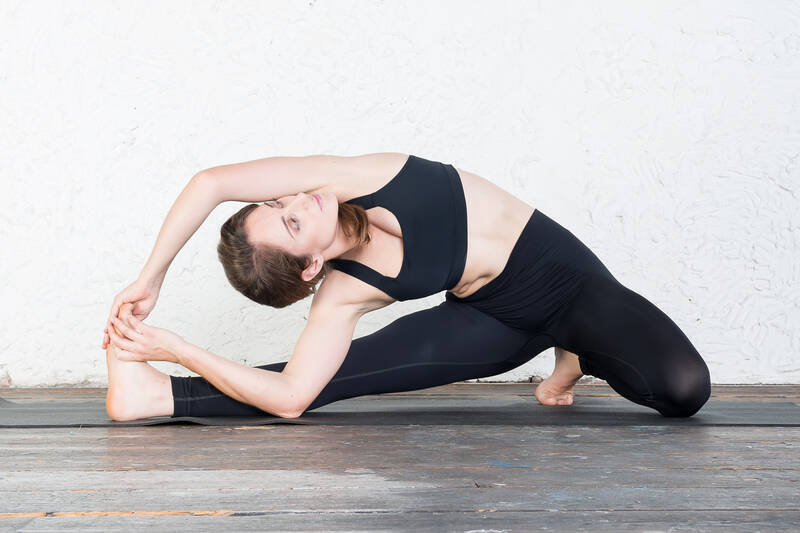
Gate Pose (Parighasana)
Gate Pose stretches the side body, including the rib cage and intercostal (between the ribs) muscles. This stimulates movement of lymph fluid in the chest and torso. An easier version of the pose applies the beneficial upper body side-stretch while easing the hip position by kneeling upright on the supporting leg instead of sitting down onto the heel.
Bow Pose - Dhanurasana
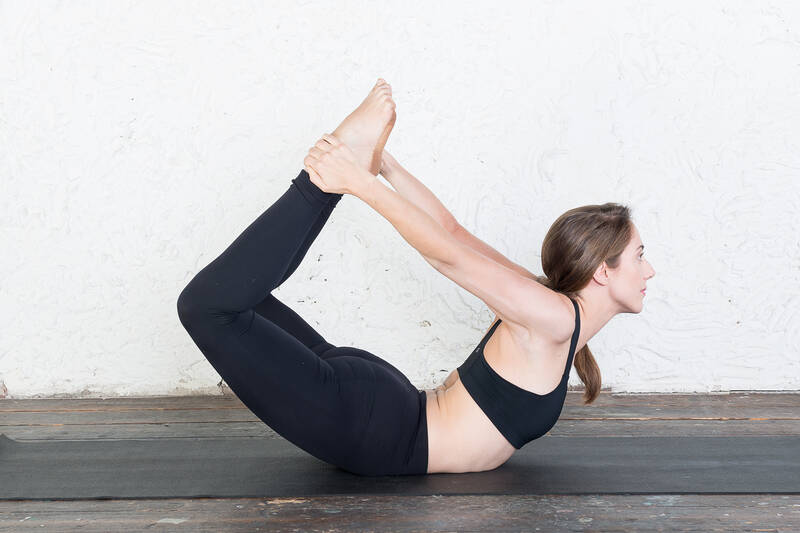
Bow Pose (Dhanurasana)
Bow Pose (Dhanurasana) is an intensive pose which should be held for maximum of 10-20 seconds for beginners. It involves a combination of less common muscle activity, partial inversion and compression to assist the lymphatic system.
Half Spinal Twist (Ardha Matsyendrasana)
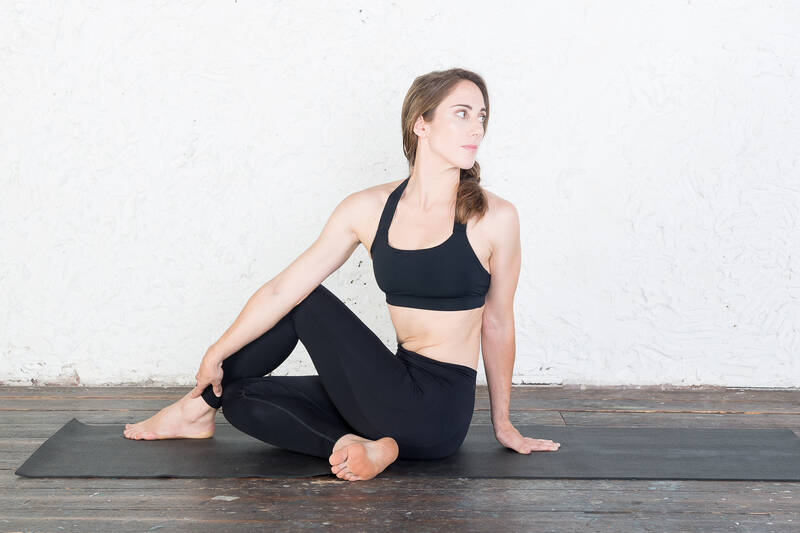
Half Spinal Twist (Ardha Matsyendrasana)
This twisting pose is comfortable for many people, and can be held for up to a minute for beginners. Remember, after relaxing in a resting pose, to practice the twist to the other side. The benefits of half spinal twist include stimulating the lymph flow in the torso, and also stimulating the Solar Plexus Chakra and therefore the functions of the stomach, gallbladder, liver, spleen, and pancreas. These organs are important in the body’s natural digestive waste processing and blood detoxification processes.
Revolved Side Angle Pose (Parivrtta Parshvakonasana)
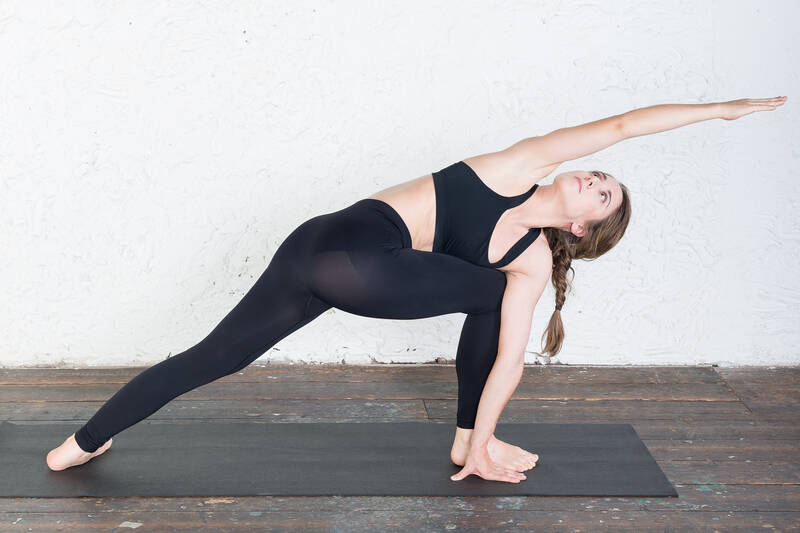
Revolved Side Angle Pose (Parivrtta Parshvakonasana)
An intense pose, Revolved Side Angle provides a deep twist to stimulate lymph flow in the torso. It’s often modified by bending the arms and pressing the palms together, and can also be practiced with the back knee lowered to the floor. This pose should be practiced for 30 to 45 seconds on each side, but be sure to relax in a resting pose before changing sides.
Conclusion
When it comes to ridding ourselves of toxins, regular healthy habits will always beat a juice fast or a two-week liver cleanse plan. Supporting our body in its natural functions is both holistic and scientifically verified as effective. Yoga provides a form of exercise that supports general health as well as specifically supporting the lymphatic system for effective detoxification of our bodies.

Get a free copy of our Amazon bestselling book directly into your inbox!
Learn how to practice, modify and sequence 250+ yoga postures according to ancient Hatha Yoga principles.

